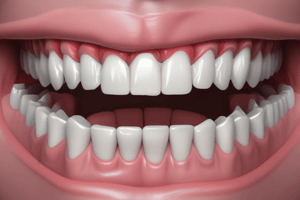Podcast
Questions and Answers
Which type of tooth tends to have roots that curve distally and fuse more posteriorly?
Which type of tooth tends to have roots that curve distally and fuse more posteriorly?
- Incisor
- Premolar
- Molar (correct)
- Canine
Which type of tooth has a deeper root groove on the distal side compared to the mesial side?
Which type of tooth has a deeper root groove on the distal side compared to the mesial side?
- Molar
- Incisor
- Canine
- Premolar (correct)
Which type of tooth has a larger crown compared to the mandibular central incisor?
Which type of tooth has a larger crown compared to the mandibular central incisor?
- Maxillary central incisor
- Mandibular canine
- Mandibular lateral incisor
- Maxillary lateral incisor (correct)
Which type of tooth has a more curved CEJ on the mesial side?
Which type of tooth has a more curved CEJ on the mesial side?
Which type of tooth may appear tilted distally on the root?
Which type of tooth may appear tilted distally on the root?
Flashcards are hidden until you start studying
Study Notes
Characteristics of Teeth
- Maxillary lateral incisors tend to have roots that curve distally and fuse more posteriorly.
- Maxillary lateral incisors have a deeper root groove on the distal side compared to the mesial side.
- Maxillary lateral incisors have a larger crown compared to the mandibular central incisor.
- Maxillary lateral incisors have a more curved CEJ (cemento-enamel junction) on the mesial side.
- Maxillary lateral incisors may appear tilted distally on the root.
Studying That Suits You
Use AI to generate personalized quizzes and flashcards to suit your learning preferences.



